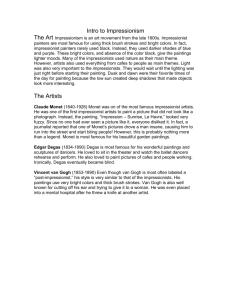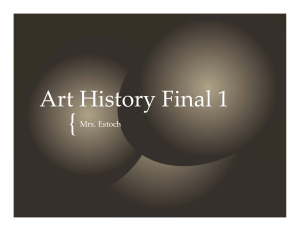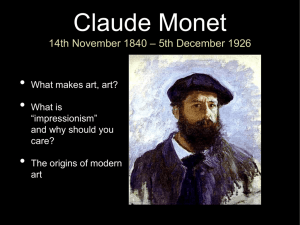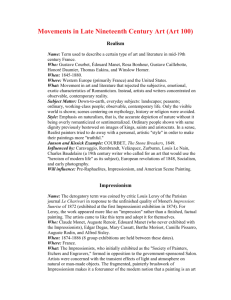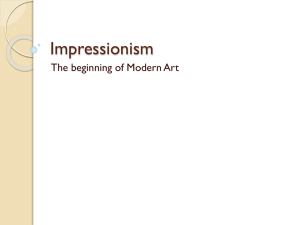Landscapes
advertisement
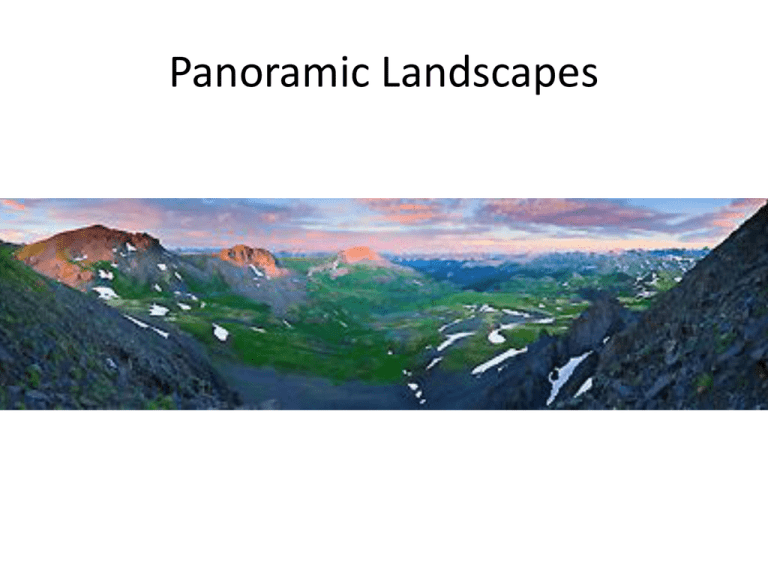
Panoramic Landscapes Landscapes = a painting, drawing or photograph that depicts outdoor scenery. What are some different types of landscapes you have seen before? 3 parts to any Landscape: • Foreground The part closest to the viewer • Middle ground The part between the foreground and background • Background The part furthest away Can you find the 3 parts of the landscape in this painting? Horizon Line = place where earth and sky meet Perspective: = the illusion of depth on a flat surface A “drawing trick” to help you show depth on a 2-D surface. Use these “rules” to make your drawings and paintings of still-life and landscapes more realistic. • Ways that artists show perspective: –Overlapping (closer objects will be in front of things behind) –Placement (closer to horizon line) –Size (farther away = smaller) –Color (farther away = duller) Overlapping closer objects are in front of things farther away Placement The farther away, the closer to horizon line Size farther away = smaller Color farther away = duller, less intense Examples of objects to include in a landscape: • trees, forest, bushes, flowers, rocks, mountains, roads/paths, bridge, pond, river, stream, animals, garden, lily pad, cactus… try NOT to include man-made objects! More things to consider… Place: • Desert, Mountains, River, Ocean, Lake, Field Weather/Climate: • Rain, sunny, cloudy, hot, wet, dry… • Season: winter, spring, summer, fall… • • • • Time of day: Sunrise Sunset Mid-day Night-time panoramic • An unbroken view of an entire surrounding area. Hudson River School • 1855-1875. • Art movement by a group of landscape painters who showed America in a romantic way; idealized view Late 19th century. 1870’s1890’s Impressionism PARIS was where it started, the center of the art world, then it spread to other parts of EUROPE Impressionist painters were considered radical in their time because they broke many of picture-making rules set by earlier generations. They found many of their subjects in life around them rather than in history * Their goal was to create an impression of their subject; quick glimpse What do these have in common??? • Most people see Impressionism as beautiful, sunlit paintings of the French countryside and gorgeous gardens. But in 1874 when they first exhibited their work, they were considered shocking and outrageous. • “What do we see in the work of these men? Nothing but defiance, almost an insult to the tastes and intelligence of the public.” 1874 • “There is little doubt that Impressionist landscape paintings are the most appreciated works of art ever produced.” 1984 Impressionism Here's a list that might help to remember the issues important to most Impressionists: E L B O W Everyday life Light and Color Brushstrokes Outdoor settings Weather and atmosphere Next we’ll see examples of this… Impressionism Everyday Life The impressionists tried to paint what they saw at a given moment. Rather than painting historical, religious, or mythological subjects, the Impressionists chose to paint everyday scenes from the world they knew. Impressionism Light and Color The Impressionists used vibrant, light colors, sometimes mixed directly on the canvas. This technique and application was much different than the darker colors used earlier in traditional art. Impressionism Brushstrokes: are visible Fascinated with capturing movement, Impressionists applied their paint with quick, brushstrokes. Impressionism Outdoor setting: The Impressionists valued nature as a subject for their paintings. Unlike academic artists, they painted real life landscapes as they saw them. They often painted outdoors, rather than in a studio, so they could observe nature more directly. BECAUSE train travel became easy to do landscape painting. Also portable easels, folding chairs, and easy tube paints were invented. Impressionism Weather & Atmosphere The Time of day, Atmosphere, and Season can be seen in their paintings. Impressionism Claude Monet “IMPRESSION, SUNRISE”,1872 gave the name to the entire Impressionist movement. As an insult these were called “impressions” instead of paintings by critics. Although the work of the Impressionist painters appears very spontaneous, they carefully and scientifically planned their work. Impressionism: Capturing Light and Color Claude Monet Rouen Cathedral Monet’s Studies of Light and Color Monet bridged the span between realism and contemporary abstraction. Part of a series of around 30 paintings. The more he worked outdoors the more he realized that colors were constantly changing with the moving of the sun, clouds, and haze.These paintings show how colors change with the light. So he decided to paint the same subject at different times of the day, year, and light. There are more than 30 canvases. Rouen Cathedral Series link Monet’s House: Giverny, France Monet’s Japanese Gardens photos paintings Examples of pastel landscapes: More Examples: And More Examples: How you will be graded: • Composition: foreground, middle ground and background • Use of perspective techniques: overlap, size, placement, focus, brightness • Mastery of chalk pastel: blending, values, and textures Review: where’s the foreground, middle ground, background, horizon line ??
